For which of the following states did the Emancipation Proclamation declare slaves, “forever free?”
A. New York
Incorrect. The Emancipation Proclamation only freed those slaves of states in rebellion. Texas is the only Confederate state on the list of answer choices.
B. New Jersey
Incorrect. The Emancipation Proclamation only freed those slaves of states in rebellion. Texas is the only Confederate state on the list of answer choices.
C. Texas
Correct! The Emancipation Proclamation only freed those slaves of states in rebellion. Texas is the only Confederate state on the list of answer choices.
D. All of the above
Incorrect. The Emancipation Proclamation only freed those slaves of states in rebellion. Texas is the only Confederate state on the list of answer choices.

Which of these following quotes best justifies the military strategy shown in the above picture?
A. "War is cruelty — you cannot refine it."
Correct! The burning of things like railroads which are potentially militarily useful, despite their harm to civilians, is part of the cruelty of war.
B. “Armies should never cause damage that hurts civilians.”
Incorrect. The total war strategy of the above picture willingly risks damage to civilians. The concept of the cruelty of war justifies total war.
C. “Sherman’s armies have committed the greatest crimes in the history of war.”
Incorrect. The quote specifically opposes the burning of things like railroad stations done by General Sherman. The concept of the cruelty of war justifies total war.
D. “I do not know how we are going to feed our families after the Union army has come through.”
Incorrect. The quote complains about the burning of food and other items as part of a total war strategy. The concept of the cruelty of war justifies total war.
"With malice toward none, with charity for all, with firmness in the right as God gives us to see the right, let us strive on to finish the work we are in, to bind up the nation's wounds . . . to do all which may achieve and cherish a just and lasting peace among ourselves and with all nations."
--Abraham Lincoln, Second Inaugural Address
The above quote from Lincoln expressed his desire —
A. to abolish slavery
Incorrect. While Lincoln earlier in the speech talks about the need to end slavery, this quote refers to his desire for a just and lasting peace that does not seek revenge.
B. to punish the South as part of a total war policy
Incorrect. In this quote, Lincoln specifically wants to do the opposite of punishing the South by creating a just and lasting peace.
C. to limit the expansion of slavery in the territories
Incorrect. Earlier in the speech, Lincoln spoke about limiting the expansion of slavery as his position on the issue when the war started, but now he wants to end it. Either way, the quote does not address slavery but the need for a just peace that does not seek revenge.
D. to create a just peace that will heal the country, not seek revenge
Correct! This quote beautifully states Lincoln’s hope for a lasting peace that will heal the country. Unfortunately, John Wilkes Booth will deny him the opportunity to try and implement it.
| Chorus, Union Version: | Chorus, Confederate Version: |
| The Union forever! Hurrah, boys, hurrah! Down with the traitor, up with the star; While we rally round the flag, boys, rally once again, Shouting the battle cry of freedom! |
Our Dixie forever! She's never at a loss! Down with the eagle and up with the cross! We'll rally 'round the bonny flag, we'll rally once again, Shout, shout the battle cry of Freedom! |
The two choruses of the Battle Cry of Freedom above demonstrate —
A. only the Union thought it was fighting for freedom
Incorrect. Both sides thought they were fighting for freedom.
B. only the Confederacy thought it was fighting for freedom
Incorrect. Both sides thought they were fighting for freedom.
C. the two sides were angry with each other, but shared similar history and thought they were fighting for the same principles
Correct! The competing versions of the Battle Cry of Freedom show the similarity between the two sides as much as it shows their dislike of each other.
D. the Confederacy also used an eagle as a symbol of the country
Incorrect. The competing versions of the Battle Cry of Freedom show the similarity between the two sides as much as it shows their dislike of each other. The Confederate lyrics reject the eagle in favor of the cross.